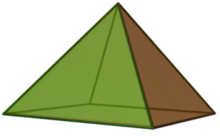| Square pyramid | |
|---|---|
 | |
| Type | Pyramid, Johnson J92 – J1 – J2 |
| Faces | 4 triangles 1 square |
| Edges | 8 |
| Vertices | 5 |
| Vertex configuration | [1] |
| Symmetry group | |
| Volume | |
| Dihedral angle (degrees) | Equilateral square pyramid:[1]
|
| Dual polyhedron | self-dual |
| Properties | convex, elementary (equilateral square pyramid) |
| Net | |
 | |
In geometry, a square pyramid is a pyramid with a square base, having a total of five faces. If the apex of the pyramid is directly above the center of the square, it is a right square pyramid with four isosceles triangles; otherwise, it is an oblique square pyramid. When all of the pyramid's edges are equal in length, its triangles are all equilateral. It is called an equilateral square pyramid, an example of a Johnson solid.
Square pyramids have appeared throughout the history of architecture, with examples being Egyptian pyramids and many other similar buildings. They also occur in chemistry in square pyramidal molecular structures. Square pyramids are often used in the construction of other polyhedra. Many mathematicians in ancient times discovered the formula for the volume of a square pyramid with different approaches.
- ^ a b Johnson (1966).


